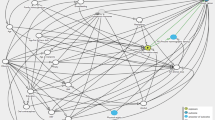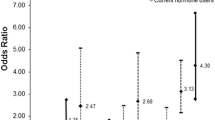Abstract
Purpose
To develop a model to predict percent mammographic density (MD) using questionnaire data and mammograms from controls in the Nurses’ Health Studies’ nested breast cancer case–control studies. Further, we assessed the association between both measured and predicted percent MD and breast cancer risk.
Methods
Using data from 2,955 controls, we assessed several variables as potential predictors. We randomly divided our dataset into a training dataset (two-thirds of the dataset) and a testing dataset (one-third of the dataset). We used stepwise linear regression to identify the subset of variables that were most predictive. Next, we examined the correlation between measured and predicted percent MD in the testing dataset and computed the r 2 in the total dataset. We used logistic regression to examine the association between measured and predicted percent MD and breast cancer risk.
Results
In the training dataset, several variables were selected for inclusion, including age, body mass index, and parity, among others. In the testing dataset, the Spearman correlation coefficient between predicted and measured percent MD was 0.61. As the prediction model performed well in the testing dataset, we developed the final model in the total dataset. The final prediction model explained 41% of the variability in percent MD. Both measured and predicted percent MD were similarly associated with breast cancer risk adjusting for age, menopausal status, and hormone use (OR per five unit increase = 1.09 for both).
Conclusion
These results suggest that predicted percent MD may be useful for research studies in which mammograms are unavailable.


Similar content being viewed by others
References
Byrne C et al (1995) Mammographic features and breast cancer risk: effects with time, age, and menopause status. J Natl Cancer Inst 87(21):1622–1629
Martin LJ, Boyd NF (2008) Mammographic density. Potential mechanisms of breast cancer risk associated with mammographic density: hypotheses based on epidemiological evidence. Breast Cancer Res 10(1):201
Martin LJ et al (2010) Family history, mammographic density, and risk of breast cancer. Cancer Epidemiol Biomarkers Prev 19(2):456–463
Boyd NF et al (2005) Mammographic breast density as an intermediate phenotype for breast cancer. Lancet Oncol 6(10):798–808
Sellers TA et al (2007) Association of childhood and adolescent anthropometric factors, physical activity, and diet with adult mammographic breast density. Am J Epidemiol 166(4):456–464
Brisson J et al (1984) Height and weight, mammographic features of breast tissue, and breast cancer risk. Am J Epidemiol 119(3):371–381
Boyd NF et al (2011) Mammographic density and breast cancer risk: current understanding and future prospects. Breast Cancer Res 13(6):223
Rice, M.S., et al., Immunoassay and Nb2 lymphoma bioassay prolactin levels and mammographic density in premenopausal and postmenopausal women the Nurses’ Health Studies. (1573–7217 (Electronic))
Rice MS et al (2016) Mammographic density and breast cancer risk: a mediation analysis. Breast Cancer Res 18(1):94
Yaghjyan L et al (2016) Reproductive factors related to childbearing and mammographic breast density. Breast Cancer Res Treat 158(2):351–359
Yaghjyan L et al (2012) Relationship between breast cancer risk factors and mammographic breast density in the Fernald community cohort. Br J Cancer 106(5):996–1003
Rice MS et al (2015) Reproductive and lifestyle risk factors and mammographic density in Mexican women. Ann Epidemiol 25(11):868–873
Bertrand KA et al (2015) Body fatness during childhood and adolescence and breast density in young women: a prospective analysis. Breast Cancer Res 17:95
Rosner B (1983) Percentage points for a generalized ESD many-outlier procedure. Technometrics 25:165–172
Wolfe JN (1976) Breast patterns as an index of risk for developing breast cancer. Am J Roentgenol 126(6):1130–1137
Wolfe JN (1976) Risk for breast cancer development determined by mammographic parenchymal pattern. Cancer 37(5):2486–2492
Kato I et al (1995) A nested case–control study of mammographic patterns, breast volume, and breast cancer (New York City, NY, United States). Cancer Causes Control 6(5):431–438
Saftlas AF et al (1989) Mammographic parenchymal patterns as indicators of breast cancer risk. Am J Epidemiol 129(3):518–526
Brisson J et al (1982) Mammographic features of the breast and breast cancer risk. Am J Epidemiol 115(3):428–437
Boyd NF et al (2007) Mammographic density and the risk and detection of breast cancer. N Engl J Med 356(3):227–236
Kerlikowske K (2007) The mammogram that cried Wolfe. N Engl J Med 356(3):297–300
Pettersson A et al (2014) Mammographic density phenotypes and risk of breast cancer: a meta-analysis. J Natl Cancer Inst 106(5):dju078
Tice JA et al (2008) Using clinical factors and mammographic breast density to estimate breast cancer risk: development and validation of a new predictive model. Ann Intern Med 148(5):337–347
Darabi H et al (2012) Breast cancer risk prediction and individualised screening based on common genetic variation and breast density measurement. Breast Cancer Res 14(1):R25
Vachon CM et al (2007) Mammographic density, breast cancer risk and risk prediction. Breast Cancer Res 9(6):217
Warwick J et al (2014) Mammographic breast density refines Tyrer-Cuzick estimates of breast cancer risk in high-risk women: findings from the placebo arm of the International Breast Cancer Intervention Study I. Breast Cancer Res 16(5):451
Brentnall AR et al (2015) Mammographic density adds accuracy to both the Tyrer-Cuzick and Gail breast cancer risk models in a prospective UK screening cohort. Breast Cancer Res 17(1):147
Bertrand KA et al (2012) Determinants of plasma 25-hydroxyvitamin D and development of prediction models in three US cohorts. Br J Nutr 108(10):1889–1896
Liu E et al (2010) Predicted 25-hydroxyvitamin D score and incident type 2 diabetes in the Framingham offspring study. Am J Clin Nutr 91(6):1627–1633
Millen AE et al (2010) Predictors of serum 25-hydroxyvitamin D concentrations among postmenopausal women: the Women’s Health Initiative Calcium plus Vitamin D clinical trial. Am J Clin Nutr 91(5):1324–1335
Jung S et al (2014) Predicted 25(OH)D score and colorectal cancer risk according to vitamin D receptor expression. Cancer Epidemiol Biomarkers Prev 23(8):1628–1637
Joh HK et al (2013) Predicted plasma 25-hydroxyvitamin D and risk of renal cell cancer. J Natl Cancer Inst 105(10):726–732
Varghese JS et al (2012) Mammographic breast density and breast cancer: evidence of a shared genetic basis. Cancer Res 72(6):1478–1484
McCormack VA, dos Santos I (2006) Silva, Breast density and parenchymal patterns as markers of breast cancer risk: a meta-analysis. Cancer Epidemiol Biomarkers Prev 15(6):1159–1169
Eng A et al (2014) Digital mammographic density and breast cancer risk: a case–control study of six alternative density assessment methods. Breast Cancer Res 16(5):439
Burton A et al (2016) Mammographic density assessed on paired raw and processed digital images and on paired screen-film and digital images across three mammography systems. Breast Cancer Res 18(1):130
Acknowledgments
We would like to thank the participants of the Nurses’ Health Study and Nurses’ Health Study II for their continuing contributions. We thank the following state cancer registries for their help: AL, AZ, AR, CA, CO, CT, DE, FL, GA, ID, IL, IN, IA, KY, LA, ME, MD, MA, MI, NE, NH, NJ, NY, NC, ND, OH, OK, OR, PA, RI, SC, TN, TX, VA, WA, WY. The authors assume full responsibility for analyses and interpretation of these data.
Funding
This study was supported by research grants from the National Cancer Institute, National Institutes of Health, UM1 CA186107, P01 CA87969, UM1 CA176726, R01 CA175080, R01 CA124865, and R01 CA131332, Avon Foundation for Women, Susan G. Komen for the Cure®, and Breast Cancer Research Foundation.
Author information
Authors and Affiliations
Corresponding author
Ethics declarations
Conflict of interest
The authors have no conflicts of interest to declare.
Ethical approval
All procedures performed in studies involving human participants were in accordance with the ethical standards of the institutional and/or national research committee and with the 1964 Helsinki declaration and its later amendments or comparable ethical standards.
Electronic supplementary material
Below is the link to the electronic supplementary material.
Rights and permissions
About this article
Cite this article
Rice, M.S., Rosner, B.A. & Tamimi, R.M. Percent mammographic density prediction: development of a model in the nurses’ health studies. Cancer Causes Control 28, 677–684 (2017). https://doi.org/10.1007/s10552-017-0898-7
Received:
Accepted:
Published:
Issue Date:
DOI: https://doi.org/10.1007/s10552-017-0898-7




